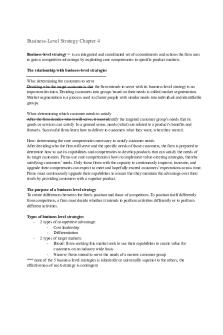Chapter 4 MGT 480 Business-Level Strategy PDF

| Title | Chapter 4 MGT 480 Business-Level Strategy |
|---|---|
| Course | Strategic Management |
| Institution | Central Connecticut State University |
| Pages | 3 |
| File Size | 159 KB |
| File Type | |
| Total Downloads | 62 |
| Total Views | 897 |
Summary
Chapter 4: Business-Level StrategyReach, Richness, and Affiliation Reach - Revolves around the firm’s access and connection to customers - An especially critical dimension for social networking sites Richness - Concerns the depth and detail of the two-way flow of information between the firm and cus...
Description
Chapter 4: Business-Level Strategy Reach, Richness, and Affiliation Reach - Revolves around the firm’s access and connection to customers - An especially critical dimension for social networking sites Richness - Concerns the depth and detail of the two-way flow of information between the firm and customers Affiliation - Concerned with facilitating useful interactions with customers 1. Who: Determining the Customers to Serve - Market Segmentation: The process of dividing customers into groups based on their needs - Table 4.1 Basis for Customer Segmentation (consumer markets and industrial markets) 2. What: Determining Which Customers Needs to Satisfy 3. How: Determining Core Competencies Necessary to Satisfy Customer Needs The Purpose of a Business-Level Strategy - To create differences between the firm’s position and those of its competitors Business Model: describes what a firm does to create, deliver, and capture value for its stakeholders - Freemium model - An advertising model - A peer to peer model Types of Business-Level Strategies - When selecting business level strategy, firms evaluate 2 types of potential competitive advantages: lower cost than rivals or the ability to differentiate and command a premium price that exceeds the extra cost of doing so - Two types of target markets are broad market and narrow market segments 1. Cost leadership → an integrated set of actions taken to produce products with features that are acceptable to customers at the lowest cost, relative to that of competitors
-
Examples of value creating activities associated with the cost leadership strategy above - Rivalry with existing competitors - Bargaining power of buyers (customers) - Bargaining power of suppliers - Potential entrants - Product substitutes Competitive risks of the cost leadership - The processes used by the cost leader to produce and distribute its products could become obsolete because of competitors’ innovations - Too much focus by the cost leader on cost reduction may occur at the expense of trying to understand the customers’ perceptions of competitive levels of differentiation - Imitation is also a risk 2. Differentiation → an integrated set of actions taken to produce products (at an acceptable cost) that customers perceive as being different in ways that are important to them
-
Examples of value creating activities associated with differentiation strategy - Rivalry with existing competitors - Bargaining power of buyers (customers) - Bargaining power of suppliers - Potential entrants - Products substitutes Competitive risks of the differentiation strategy - Customers may decide that the price differential between the differentiator’s product and the cost leader's product is too large - A firm’s means of differentiation may cease to provide value for which customers are willing to pay or that how the firm seeks to differentiate its offerings is unclear to target customers - Experience can narrow customers’ perceptions of the value of a products’ differentiated features - Counterfeiting is the fourth risk - Failing to provide crisp and identifiable differentiation to customers in the form of a firm’s products is a fifth risk 3. Focused cost leadership - Focused strategy: an integrated set of actions taken to produce products that serve the needs of a particular segment of customers 4. Focused differentiation Competitive Risks of Focus Strategies - A competitor may be able to focus on a more narrowly defined competitive segment and thereby “out-focus” the focuser - A company competing on an industry wide basis may decide that the market segment served by the firm using a focus strategy is attractive and worthy of competitive pursuit - That needs to customers within a narrow competitive segment may become more similar to those of industry wide customers as a whole over time 5. Integrated cost leadership/differentiation → finds a firm engaging simultaneously in primary value chain activities and support functions to achieve a low cost position with some product differentiation - Flexible manufacturing systems - Information networks - Total Quality Management Systems (TQM): Involves the implementation of appropriate tools/techniques to provide products and services to customers with the best quality → firms develop these systems to increase customer satisfaction, cut costs, and reduce the amount of time required to introduce innovative products to the marketplace Competitive Risks of this strategy - Firms failing to perform the value chain activities and support functions in an optimum manner when implementing the integrated cost leadership/differentiation strategy become stuck in the middle...
Similar Free PDFs

TB-Chapter 4-Strategy
- 67 Pages

Chapter 12 MGT Notes
- 4 Pages

MGT 3110 chapter 13
- 3 Pages

MGT 181 Chapter 14 Notes
- 4 Pages

MGT 181 Chapter 2 Notes
- 5 Pages

MGT 181 Chapter 7 Notes
- 8 Pages

ELM-480-T7-Class Profile
- 2 Pages

Chapter 09 Cooperative Strategy
- 24 Pages

Chapter 7 Process Strategy
- 3 Pages
Popular Institutions
- Tinajero National High School - Annex
- Politeknik Caltex Riau
- Yokohama City University
- SGT University
- University of Al-Qadisiyah
- Divine Word College of Vigan
- Techniek College Rotterdam
- Universidade de Santiago
- Universiti Teknologi MARA Cawangan Johor Kampus Pasir Gudang
- Poltekkes Kemenkes Yogyakarta
- Baguio City National High School
- Colegio san marcos
- preparatoria uno
- Centro de Bachillerato Tecnológico Industrial y de Servicios No. 107
- Dalian Maritime University
- Quang Trung Secondary School
- Colegio Tecnológico en Informática
- Corporación Regional de Educación Superior
- Grupo CEDVA
- Dar Al Uloom University
- Centro de Estudios Preuniversitarios de la Universidad Nacional de Ingeniería
- 上智大学
- Aakash International School, Nuna Majara
- San Felipe Neri Catholic School
- Kang Chiao International School - New Taipei City
- Misamis Occidental National High School
- Institución Educativa Escuela Normal Juan Ladrilleros
- Kolehiyo ng Pantukan
- Batanes State College
- Instituto Continental
- Sekolah Menengah Kejuruan Kesehatan Kaltara (Tarakan)
- Colegio de La Inmaculada Concepcion - Cebu






